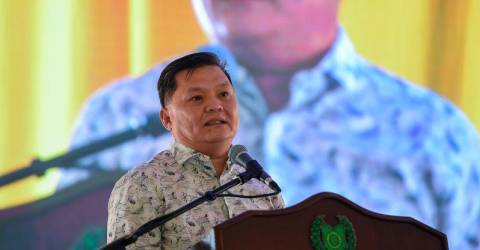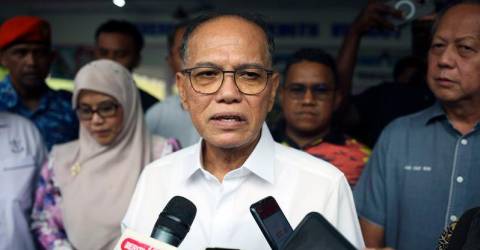ADVERTISE HERE
GUA MUSANG: Safeguarding and revitalising Malaysia’s minority languages deserve serious attention as they constitute a part of the nation’s rich cultural heritage that future generations must be aware of.
Globally, language experts estimate that some 6,000 languages, most of them oral languages spoken by minority groups, face extinction in the next 100 years or so.
In Malaysia, about 80 percent of the estimated 137 languages spoken in the country comprise indigenous languages, including Mendriq which is expected to vanish in 20 years if no efforts are taken to preserve it.
Mendriq is the ancestral language of the Mendriq Orang Asli community, a minority subgroup of the Negrito group (which is one of the three main Orang Asli groups in Peninsular Malaysia, the other two being Senoi and Proto-Malay).
Over the years, it became increasingly challenging for the Mendriq elders to preserve their native language as their tribe is dwindling in size with only 600 of them left now, all of them dwelling in Kelantan in three locations, Kampung Kuala Lah in Gua Musang and Kampung Pasir Linggi and Sungai Tako in Kuala Krai.
Associate Prof Dr Salinah Jaafar, a senior lecturer at the Malay Linguistics Department, Academy of Malay Studies, Universiti Malaya, said among the efforts that can be taken to preserve and sustain the languages of minority communities is documenting all forms of the languages in digital formats that can be easily accessed by researchers, users and language enthusiasts.
“Apart from that, there must also be efforts to rekindle minority languages through cultural and artistic activities so that both local and international communities are aware of their existence. These languages are, after all, a part of the nation’s linguistic heritage that must be preserved and recorded for the reference of our future generations,” she said.
Salinah said based on a study titled “Proto-Malay Orang Asli Language: Language or Malay Dialect?” carried out by academics from her department in 2014, it was found that a significant number of dialects and languages used by minority communities in this region originated from the same language family, namely the Austronesian family – they were related to each other and shared similarities in social and cultural characteristics.
“This is why we are encouraging more researchers and language scholars to research the ‘lifestyle’ of minority languages so that they can be preserved,” she added.
Social interactions
Meanwhile, Associate Prof Dr Fazal Mohamed Sultan, a lecturer at the Centre for Research in Language and Linguistics, Universiti Kebangsaan Malaysia, said in the case of the Mendriq language, what makes it even more challenging to preserve is the fact that it is categorised as part of the Austroasiatic language stock.
He said the Mendriq tribe is categorised as speakers of the Mon-Khmer language family (which is part of the Austroasiatic family) but has allowed an influx of vocabulary from the Malay language which is part of the Austronesian language family.
Apart from Malay, the native languages of the Proto-Malay Orang Asli and the indigenous groups of Sabah and Sarawak also originated from the Austronesian language family, while the native languages of the Negrito and Senoi Orang Asli groups hail from the Austroasiatic family.
Fazal said the difference between the Austronesian and Austroasiatic languages lies in the syntactic status of words, types of phrases, clauses and complex sentences.
“In terms of morphology, Austronesian languages are characterised by agglutination (the addition of affixes to base words to indicate grammatical functions). The Austroasiatic (communities), on the other hand, use their own languages according to the ethnic group they belong to,” he told Bernama recently.
He also said studies carried out since 2007 showed the Mendriq community’s younger generation preferred to use Bahasa Melayu, and not their mother tongue, to communicate with each other daily.
He said this situation arose due to the social interactions between the Mendriq community and the Malays, coupled with the former’s minority status.
Efforts must continue
In the meantime, Wikimedia Community User Group Malaysia (Wikimedia Malaysia) is involved in efforts to preserve the Mendriq language by inputting Mendriq words into online multilingual dictionary Wiktionary.
In October, it organised a two-day workshop at Kampung Kuala Lah, Gua Musang, where volunteers collaborated with the local Mendriq community to input as many Mendriq words as possible into the online dictionary.
Wikimedia Malaysia also participated in the 2023 Wikimania Conference in Singapore in August, which was organised by Wikimedia Foundation and attended by 3,000 delegates from 138 countries.
Wikimedia Malaysia president Dody Ismoyo said their involvement in this year’s edition of the conference was aimed at promoting and preserving the uniqueness of the linguistic heritage of every minority community in Malaysia, particularly the Mendriq community’s dying native language.
He said at the conference, their delegate Ahmad Wafiq Aqil Kamarul presented the challenges and efforts undertaken by Wikimedia Malaysia to elevate the Mendriq language so that it would not disappear with the passage of time.
“By providing the Mendriq community with the Wiktionary platform, they themselves can enter the (Mendriq) words and sentences onto the online dictionary,” he said.
Indonesian delegate to the conference Ilham Mufti Laksono, 28, praised Wikimedia Malaysia’s approach to saving the Mendriq language from the threat of extinction.
“But such efforts have to be done continuously,” he said, adding that besides their language, the Mendriq community’s culture and traditions must also be safeguarded.
Wikipedia co-founder Jimmy Wales, who was also present at the Wikimania Conference, said he hoped Wikimedia Malaysia and the public would succeed in their efforts to safeguard the Mendriq language.
He said the conference was an opportunity for delegates to engage in deeper discussions and share their experiences in preserving cultural heritages across their countries.
Wikimedia Malaysia outreach committee member Ahmad Wafiq Aqil Kamarul, meanwhile, said they will participate in more programmes next year to highlight the languages used by this country’s minority communities. One of the events they will attend is the East, Southeast Asia and the Pacific Regional Cooperation Conference 2024 in Kota Kinabalu, Sabah, from May 10 to 24. This is the third such conference for Wikimedia communities in the East, Southeast Asia and Pacific region.
He said Wikimedia Malaysia will also collaborate with the Borneo Institute for Indigenous Studies and Universiti Malaysia Sabah to upload 2,860 words from 25 Sabah ethnic languages.
“We also had a meeting with the Ethnic Language Unit at the Ministry of Education in Putrajaya to discuss the issue of sustainability of ethnic languages. We also proposed that the Wiktionary platform be used in the school syllabus,” he added.–Bernama

 1 year ago
213
1 year ago
213



 English (US) ·
English (US) ·